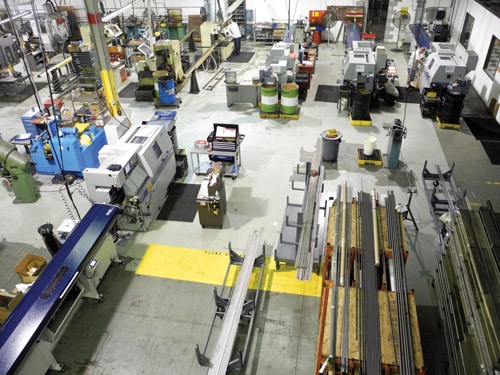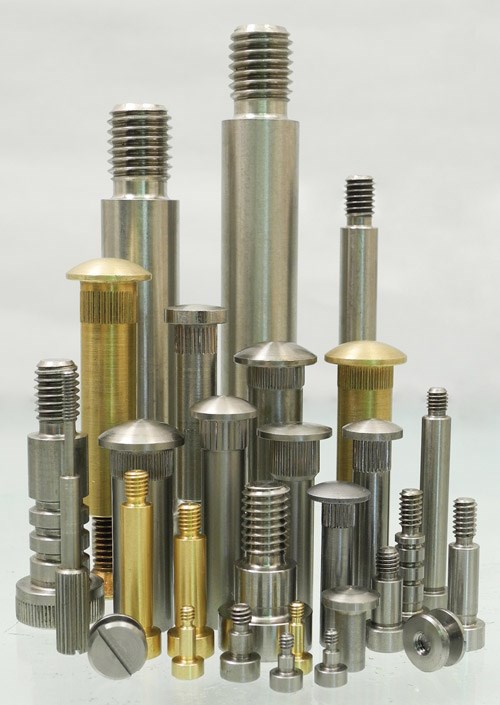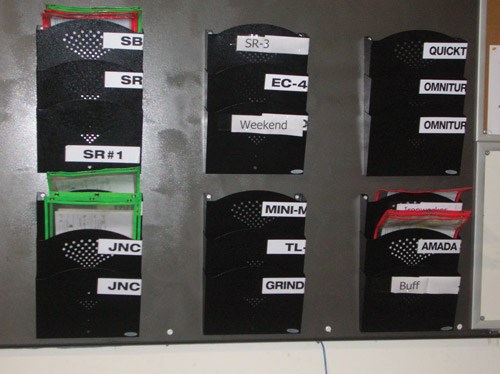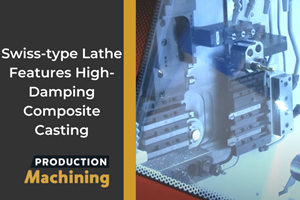Finding Better Ways to Compete
This Indiana shop has reinvented itself to succeed in a tough market that many have abandoned to foreign competition—fasteners. It’s a story of change, response and adjustment that has allowed the company to navigate through mine fields of industry change and our great recession to exit as a stronger and better business.
On a lead from George Bursac, who heads the U.S. operation for Star CNC Machine Tool, we arranged a visit to Accurate Manufactured Products Group in Indianapolis, Ind. “This facility is doing great things with Swiss turning,” Mr. Bursac says. He has directed us to successful Swiss-type shops in the past, and the visit to Accurate was no exception.
The company is a stocking manufacturer of specialty fasteners, gage and measurement accessories, machine tool productivity aids, jig and fixture components, power transmission connectors and special flat washers. It currently has 18,000 items to offer, and 85 percent of which are in the fastener industry.
The company was started in 1987 by Matt Goldberg as a master distributor, with his former company MSC (the large catalog house in Plainview, N.Y.) as his first customer. “My job at MSC was to purchase items for the catalog, most of which were sourced from overseas,” Mr. Goldberg recalls.
“When we started Accurate, we manufactured nothing,” says Mr. Goldberg. “We designed products and had job shops machine them. Then we stocked them, sent them out for secondary operations such as heat treat or coating, and then did the assembly and packaging in house. In time, we were replacing foreign manufactured items with domestically sourced items while meeting or beating the competition’s prices. We were reshoring before reshoring was cool.”
Then it dawned on him that his company could make these products itself. So in 2002, Accurate started a manufacturing operation in New York, with three Star CNC Swiss machines and a couple machining centers. Accurate became its own job shop.
Mr. Goldberg describes his business as a niche manufacturer for distribution. “Around 75 percent of our business is for the catalog industry. What we found was there was significant demand from the catalog houses for less popular items—what we call C, D and E items. We make the sizes that don’t sell in large volumes. It’s good business for them, but often it requires quick turnaround. We stock it here and try to have items available when they call.”
Mr. Goldberg readily admits he’s not a machinist. “I cut my teeth at MSC,” he says. “I know the catalog business, which is our primary customer. So for our manufacturing operation, we hire good metalworking people and empower them to make the parts, which is a prime reason for the shop’s move to Indianapolis in 2004. We found a readily available skilled workforce in the Midwest.”
The fastener business is tough. Mr. Goldberg calls it “lumpy,” reflecting the inconsistency of demand. “We may get an order for three pieces or 300—you never know. Forecasting for production goes out the window. It’s purely a pull through system, which of course, has a heavy influence on how we manufacture,” he says.
However, by choosing the right niche within the fastener industry and refining the company’s manufacturing capabilities to serve it well, Accurate has managed to remain a successful player when so much of the work has been outsourced.
Forced to Change
When Accurate made its move to Indianapolis, the company basically replicated the manufacturing structure it was using in the New York shop. It was a traditional structure consisting of a three-shift operation and typical hierarchical management including a manufacturing manager (with no machine responsibility) who reported to a vice president and shopfloor responsibility from a lead man on each shift.
“We basically packed up our shop and moved to Indianapolis,” says Mr. Goldberg. “Cost reductions were part of the move, real estate, taxes and wages were much lower than in New York. Moreover, for us to grow the business, using the traditional machine shop structure we had in place, skilled workers were needed and the available crop in Indy was better.”
Then came 2008 and the Great Recession. But 2009 was a watershed year for Accurate: It was the first time the company had any money-losing months since its founding in 1987. Order volume dropped by 35 percent in 2009, and without drastic overhead cuts in the first quarter, the company would have lost money for that year.
“This downturn was very serious,” Mr. Goldberg says. “In previous recessions, we came out of them on a growth curve. It didn’t seem necessary to question our shop structure because we were growing. The 2008-2009 recession was different, and it required quick action to save the business.
“In response to the loss, we set a cost reduction goal of establishing a $50 per hour shop rate,” he continues. “It was soon apparent that the traditional structure we were using in the shop would not allow us to achieve that goal.”
Lots of Lights Out
During the recession, the shop went from 58 employees to 33, cutting most of the traditional, non-production positions. “Many of the shop people told me that we can’t run untended,” Mr. Goldberg says. “However, a small group of employees, realizing the situation we were in, agreed to try untended machining.”
These employees didn’t understand why it was impossible to run attended. But most of the material that Accurate runs is 12L, 6061 aluminum, brass and 316 stainless. Aside from the 316, none of these materials are particularly difficult to machine. So the material wasn’t a problem for lights-out.
The Star Swiss-type machines were the logical place to begin untended machining, because of their multitasking and backworking capabilities, so the shop started loading the Star SR 32 series machines. Each machine was equipped with bar feeders, some of which were modified with feeder trays for magazine load.
Building on the shop’s base of Star machines from the New York shop, over time Accurate has added more complex and capable Swiss machines to its stable that raised production of increasingly complex workpieces without the need for operator intervention.
Part of the transition to untended machining is the ability to “bullet proof” jobs so they will run trouble free. Using reliable and predictable tooling is one method. The machinists are constantly trying new tooling geometries and grades to get the best performance. Currently, much of the Swiss machine tooling is from Ingersoll.
As with any Swiss machine, feeding the barstock through the collet and guide bushing from bar to bar is critical to continuous operation. Accurate doesn’t use ground bar, which is customary. Rather, they point the end of the bar for a sure feed. In addition, each of the Swiss machines is equipped with what Star calls its “magic guide bushing,” which automatically adjusts the guide bushing for variations from one bar to the next.
The shop is manned from 6 a.m. to 5 p.m. on weekdays. Toward the end of each day shift, the machines are set up to run through the night. A shift is scheduled for 4 hours on Saturday to load the machines for operation over the weekend. “We do this untended work across four machines and sometimes five, which equates to 40 hours of untended production over the weekend, per machine,” Mr. Goldberg says.
Currently, the shop’s machine inventory consists of four Swiss machines, one Star SB and three SR 32s, with two more on order, as well as a Mazak Quickturn that runs barstock up to 3 inches. Secondary operations and prismatic part production are performed on two Haas VMCs, a Mazak HMC and a Haas HMC.
Shoulder Screws
Investing in new technology and rededicating the workforce to untended operation has reaped large benefits for Accurate’s business. One example that Mr. Goldberg mentioned was in the shoulder screw business.
“We’re doing more shoulder screw business with our manufacturing capability, which puts us in competition with cold headers, domestic and overseas,” Mr. Goldberg says. “Obviously, using an upsetter for the screw head is faster than turning it, but it becomes a two-step process from the header machine to the lathe for threading. On our Swiss machines, we can do the part in a single handling—well, actually, no handling when we run lights out—so we can very effectively compete with anyone on throughput alone. Plus, the quality is there as is the cosmetics. Our screws simply look better, and to many of our customers, that’s important.”
Before going untended, the shop imported its shoulder screws from India. It was problematic from a couple of perspectives such as the large quantity required for a decent unit cost (5,000 pieces) and the time required to receive shipment (6 months). With the lights-out production, Mr. Goldberg ran the numbers and found he was price competitive with the Indian supplier and had the additional benefit of being able to claim compliance with the Buy American Act.
Another ace up Mr. Goldberg’s sleeve is that since the shop has gone to untended operation, it has managed to reduce its 2008 hourly rate goal of $50 using traditional machine shop structure to below $25 per hour, which makes the company globally competitive. “I can’t import most of these screws for what it costs me to make them,” he beams.
Making it Work
Obviously, with 18,000 part numbers, production control is an issue. Accurate’s system is to run lot sizes from 100 to 2,000 across the appropriate machine tool, then change-over for another job. Jobs are sequenced to run within a given bar diameter since changing the bar feeder adds time to the setup.
Because of its flat organization, Accurate empowers its people to make decisions about how to process the work. “My philosophy is that whoever is doing the work is best qualified to know how best to efficiently run the job,” Mr. Goldberg says. “Most of the employees are crosstrained and perform multiple functions within the company. For example, the shop scheduler can also operate the machines, and almost all of our machinists program as well.”
Because of their familiarity with the machines and the jobs, the machinists know the tool life of a given station and setup the machine accordingly. The Star CNC machines have a timer on the CNC that can be set for “x” number of pieces before a tool goes dull. The machinists keep records on the jobs they run.
An advantage to being a stocking shop is that often job lots are machined for inventory. There are some long run jobs with quantities of 10,000 to 20,000 that can be divided into 5,000 piece runs or less to fill untended time on the machines and then stocked for inventory. It gives some flexibility for fitting in more jobs during a shift.
Another example of production flexibility occurs toward the end of the day shift. The machinist may pull off a partially complete part run and tool up the machine for a longer run, untended job to run that night.
A result of this new manufacturing system is a much leaner and more productive operation. “When everything works right—scheduling, tooling and machines—we get more parts through the shop in a single untended shift than we did with our previous manned, three-shift structure,” Mr. Goldberg says.
Back Order Cell
While the goal of untended machining is to schedule work that keeps the spindles turning as close to 24/7 as possible, occasionally a rush job comes in. The shop deals with these jobs using what they call a back order cell.
“We keep three machine tools ready in the back order cell for unscheduled jobs of usually small quantities,” Mr. Goldberg says. “It’s a customer service aspect that has paid off well for us. We make three to ten parts in this cell, and while they may actually cost us several times the normal price, it is more expensive to cultivate a new customer.”
The process is apparently working. The company has all of its original customers since opening in 1987 as well as several new ones it has acquired through the years.
New Opportunities
Mr. Goldberg’s son, Alex, is now in the business and heads up the sales department. In addition to its core catalog business, the company is finding new work in specialty fastener fields.
Custom architectural is one of those. Architects draw up decorative, custom fasteners for buildings, and Accurate is able to manufacture the pieces. It’s a new and growing segment of the business, according to young Mr. Goldberg.
Accurate has successfully reinvented its manufacturing system and company structure to reflect the changes it has encountered through the years. Moreover, it’s a work in process. As new, more capable machines, cutting tools, software and accessories become available, this company will continue to invest in its products and processes. They understand that domestic manufacturing is more than viable, but that it cannot be set on auto-pilot.
Related Content
Video Tech Brief: Swiss-type Lathe Features High-Damping Composite Casting
A rigid casting design and chip control technology are among the various benefits of this Swiss-type lathe.
Read MoreShop Sets its Sights on Precise Tool Alignment
A Wisconsin shop has found that visual tool alignment technology has improved tool life and surface finishes for its Swiss-type lathes while increasing throughput as well.
Read MoreSwiss-Type Add-On System Enables In-Line Inspection
When small part inspection and/or segregation is critical, this flexible, automated unloading and palletizing system for Swiss-type lathes can be the answer.
Read MoreMoldmaker Finds Value in Swiss-Type Machining
This multifaceted manufacturer has added CNC sliding-headstock turning technology to complement its established mold tooling production and new injection molding capabilities as it continues to pursue complex medical work along a vertically integrated path.
Read MoreRead Next
Do You Have Single Points of Failure?
Plans need to be in place before a catastrophic event occurs.
Read MoreSeeing Automated Workpiece Measurement in Real Time
User-friendly inspection software for CNC machining centers was shown at IMTS 2024 monitoring measurements between and after machining while performing SPC based on recorded measurement values.
Read MoreA Tooling Workshop Worth a Visit
Marubeni Citizen-Cincom’s tooling and accessory workshop offers a chance to learn more about ancillary devices that can boost machining efficiency and capability.
Read More












.jpg;maxWidth=300;quality=90)













